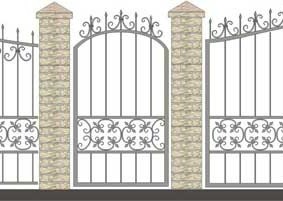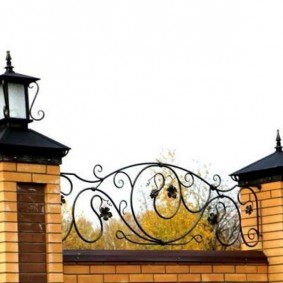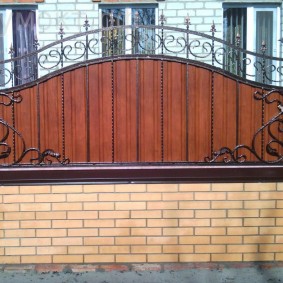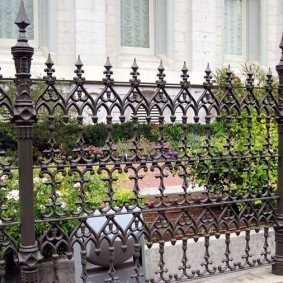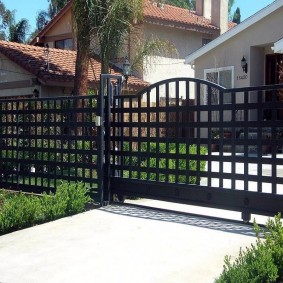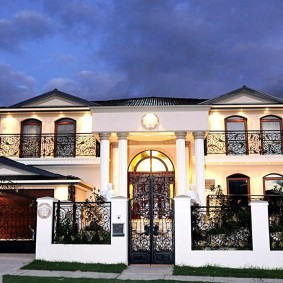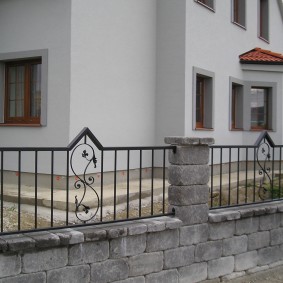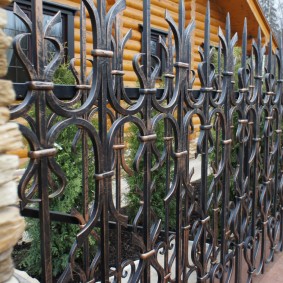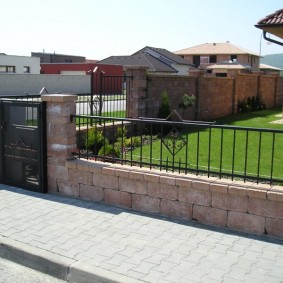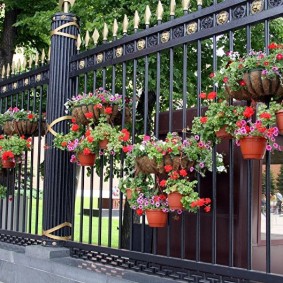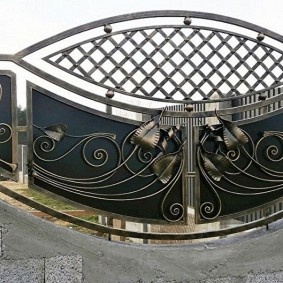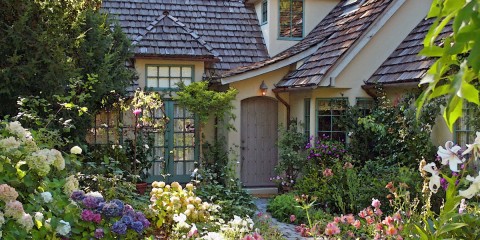 Landscape design
Lighting options for a country house and a summer cottage
Landscape design
Lighting options for a country house and a summer cottage
Forged metal fence is considered one of the most reliable options for protecting the local area. In addition, a beautiful openwork fence acts as a wonderful addition to any landscape design. A wide assortment allows you to choose any design that suits the different style of a private house.

Forged fences attract with their special aesthetic appeal
The advantages of forged fences
Content
Forged fences find their application in many places. The design is popular for its combination of physical strength and visual lightness. To assess the versatility of forged sections of a metal fence, you need to familiarize yourself with its advantages:
- High level of reliability. Thanks to manufacturing technology (metal is hardened several times), the fence becomes resistant to adverse weather conditions and mechanical damage.
- Durability (serves for many years).
- Security. The hardened metal has high strength, so it is not easy to damage the material. In addition, a large number of interwoven rods, sharp tips and small elements preclude the penetration of intruders.
- Aesthetic appeal. Many products are exclusive and are made to order. Fences with forging elements look original and beautiful.
- Easy care. It does not require constant cleaning. There is no need to dismantle the structure to remove scratches or rust.
- Wide range of. A wide variety of species allows the installation of protective, decorative (art forged fences) and combined metal gates.
- Harmonious combination with any style of construction.
- Resistance to corrosion and fire due to powder coating or galvanizing.
Forging on any fence can be made according to an individual sketch, thereby giving uniqueness and difference from typical fences.

A beautiful forged fence is the hallmark of a suburban area

The service life of forged fences is estimated at decades and even centuries, subject to timely updating of the protective coating
What is important to consider before choosing a forged fence
First of all, when choosing forged products, you need to consider the goals for which they will be used. To choose the right option, you must consider the following:
- Construction height. The optimal size is 2.5-3 m. The higher the section, the more protection it provides. A too small fence (not higher than 1.5 m) most likely performs only a decorative function.

The fence with a forged top on a stone base looks reliable and neat
- The distance between the sections. The shorter the distance, the more difficult it is for outsiders to overcome the fence.
- Main material. Traditionally, a fence with wrought iron elements is made of iron. Recently, steel has become popular. Fences made of cast iron, steel and iron rod are reliable, resistant to precipitation and corrosion. For lace lace parts, alloys of aluminum, titanium and copper are used, which increases the final cost.

The photo shows examples of forged elements for the fence of the garden
- Forged sections of the fence should be made by analogy with a gate and a wicket.
- Type of profile and thickness. You can choose a profile of 15 × 15 mm, 20 × 20 mm and 25 × 25 mm.You can also choose forged (forging) or a smooth profile (rolled steel).
- Color. Basic equipment can be sold without paint. When painting the fence, any shade is allowed.
- The presence of stubs. Protect fence posts from precipitation.
- Connection of separate sections. Welding is much more reliable than a bolted connection.
- Preparation method. Allocate cold, hot and manual forging.

With the help of hand forging, unique elements are created that make up original paintings that can tell about the tastes of the owners of the site
- Type of construction. Forged metal fence can be of open type (suitable as a decor for landscape design of a site), closed type (performs a protective function) or combined.
The weld must be of high quality. In places of welding there should be no bumps, cracks and voids.

Assembling forged elements in the intake section by welding
Design features forged fence
A metal fence, decorated with an original design idea, will be an adornment for any country house. Various ornaments, flowers, snails and other metal elements have become an integral part of forging, as art. Interesting options forged fences are presented in many photos.

The simple wrought iron fence looks restrained and solid
Forged fences are made out not only with patterns, but also with colors. At the same time, the color palette is very diverse. You can pick up fences, the forging of which has exactly that shade, which harmoniously fits into the general appearance of the site. You can add a noble retro effect by patinating sections. Gilding looks interesting and rich.

Patination and gilding add chic and presentability to the fence.

Forged fence on a high brick base - a compromise between the protective and aesthetic properties of the fence
Stylish design effect is achieved by combining metal and brick. These two materials are organically combined and complement each other. Add a product of decorativeness and stability. It is carried out in several options:
- Fence with brick pillars. The classic version, where the main part is metal spans. Can be with or without a brick base.
- Equal ratio of brick and metal. At the same time, the lower part of the fence (1-1.5 m) and the posts are made of brick, and forged elements are located between the columns.
- Fence with semicircular forging. The most interesting and artistic option. The lower part (1-1.5 m) and pillars are laid out of stone, and the spans are presented in the form of semicircular sections of metal elements.
The combination of natural greenery and metal not only improves the aesthetic appearance, but also perfectly isolates the territory. A hedge of climbing plants, braiding an iron lattice, favorably emphasizes the infield.

The forged fence twined with flowering plants looks elegant and beautiful
The most popular solution is decorating with wrought iron lamps. This design gives the designer completeness to the product. An additional element will make even the simplest option memorable. There are two ways to post:
- at the top of the fence post, in the form of a pommel (lights are welded on the leg);
- wall or pendant lights (fasteners are carried out on the supports on the side).
The use of cast elements gives volume and vivid detail to the products. Decorative decoration is made in the form of overlays or tops on fence posts, thrust bearings, balusters, rosettes and bas-reliefs, metal flowers, leaves and small sculptural forms.
Using forging, you can make a variety of compositions of any style (classicism, gothic, baroque, empire, etc.). Mixing different styles is appropriate.To determine the style, you can pre-familiarize yourself with photos of interesting options forged fences.

The baroque fence is decorated with small patterned details.
Classicism style fencing requires poise and integrity. For the construction, rods with spears in the upper part are suitable. This style involves the use of patterns of complex shapes.

Sharp peaks at the top of the classic fence will serve as a warning to uninvited guests
For fans of the Gothic style, wrought-iron gates, characterized by sharp and strict lines, are suitable. They are dominated by ornamental floral patterns.

Gothic forged luxury fence
The most popular Art Nouveau style. There are no straight lines in it, preference is given to plastic forms, bends and curls. Oriental ornaments and abstract compositions are also relevant.

Art Nouveau forging is distinguished by smooth lines and a saturation of abstract elements

Oriental-style products are complemented by painted elements.
Design options - photos and diagrams
With all the variety of drawings, patterns, shapes and decorative elements, forged fences are customarily made according to the most common patterns. Such limitations are explained by the production method and metal processing technology.

A wide variety of forged fence patterns allows you to choose the most suitable option for your site

The combination of stone, forging and wood looks original
Forged fences, photo schemes of which can be viewed before ordering, are performed as:
- Separate spans. It is made out by brick or natural stone. Supports can be made according to a foundationless scheme or connected by a socle with a height of 15 to 100 cm.
- Continuous web. The fence is mounted on steel tubular supports. The diameter of the posts is small, so the entire canvas of the forged fence looks like one continuous span.
- Steel sections with a screen. Most often, shielding is used to protect or obscure the surrounding area. Basically, a sheet metal or cellular polycarbonate is taken to install the screen. Corrugated board is also suitable. The closer the fence is to the house, the larger should be the shielding surface.

Forged fence, supplemented with profile sheets, will hide the yard from prying eyes
When planning sketches, it should be borne in mind that in the manufacturing sector there are established forms, styles and design ideas. A cardinal deviation can ruin the aesthetic appearance of the product.
There are countless design options for forged sections, here are just a few of the most common schemes:
Conclusion
Forged fences are undeniably good. At not the highest costs for metal, you can get a product with a long service life. In addition, the fence is original, reliable and gives a finished look to the suburban area.
Video: Examples of beautiful forged fences




